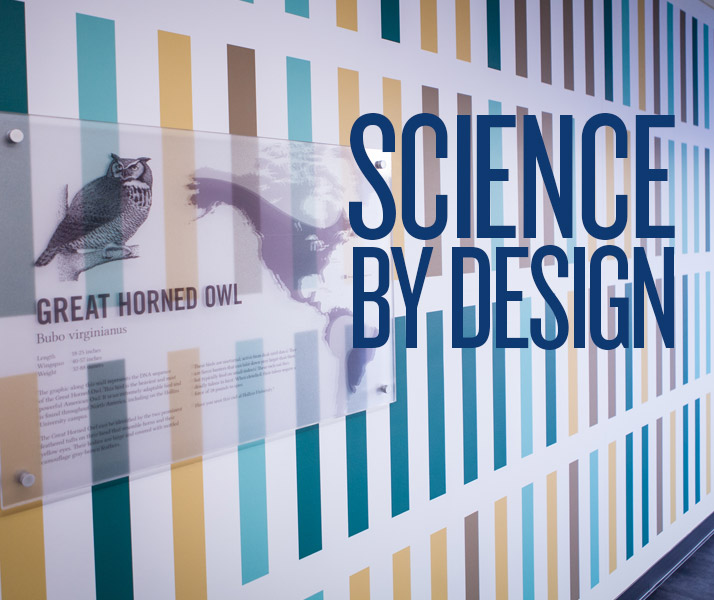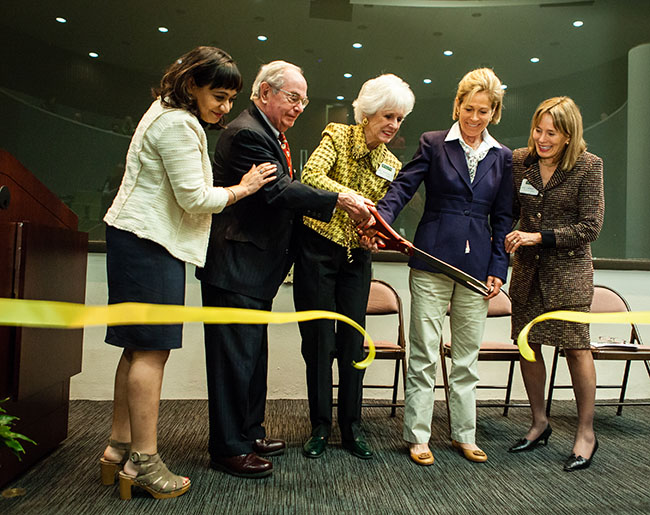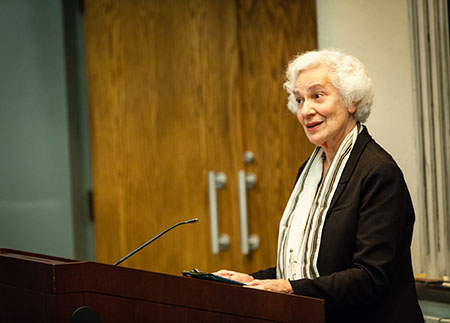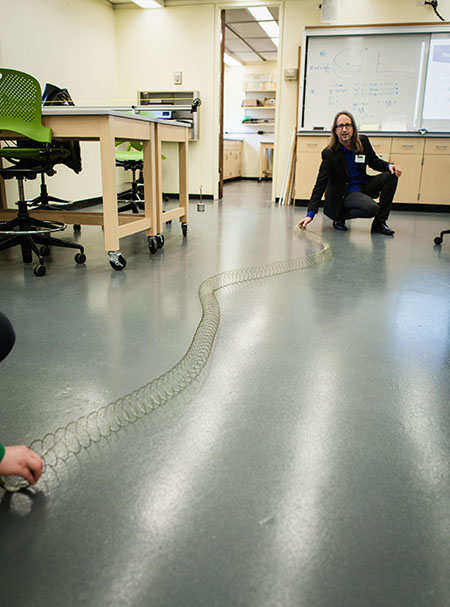
Science by Design
This wall of colorful lines in the main hallway shows the DNA sequence of the great horned owl, which can be found throughout North America—including on the Hollins campus.
Dana Science Building may look unchanged on the outside, but the inside of the 51-year-old building has been completely revamped, with new labs, offices, and study spaces. The dedication of Dana took place on February 23, the day before President Lawrence’s inauguration.
In 1967, Dana Science Building opened with much fanfare—along with a National Award of Merit from the American Institute of Architects. To meet the rising interest among students in the STEM field, Hollins recently undertook a $6.5 million renovation of Dana, the building’s first major overhaul since its construction. Renovation highlights include:
- Refreshed lobby area, featuring a wall constructed from the soapstone tabletops from the old chemistry labs
- Five new labs (two for biology and three for physics), with new research and instrument spaces for both departments
- Four refreshed labs
- New office suites with six offices on the biology hall, six offices on the chemistry and physics hall, and a group study space in each suite
- Chemistry research and project space
How does the building enhance teaching?
Daniel Derringer, associate professor and chair, chemistry
The new research labs were designed to be used by students to conduct the research they’re required to do as part of their major. The model we use is like the graduate school model. Students here are required to do a semester or year of research. More often than not, students get involved in the research faculty are doing. Our students are experiencing hands-on learning in some truly remarkable, exceptionally modem workspaces. They already love how spacious and bright the new rooms are.
Renee Godard, professor and Janet W. Spear Chair, biology
The two new labs are devoted to courses on the cellular level, while the other three labs, which were more lightly renovated, will be used for organismal and field-based courses. I am delighted with these spaces. The technology and arrangement of tables enable me to teach seminar courses and upper-level courses in the labs. This allows a fluid transition from collaborative discussion and student presentations to practical hands-on activities. The labs offer more storage space for field equipment and are friendlier spaces for the dirt, water, and outdoor specimens that are a part of ecological projects.
Brian Gentry, visiting assistant professor, physics
Physics is an active discipline, and the bright and open spaces allow space for movement of both minds and bodies. The dry-erase boards and dry-erase wall in the main room facilitate the flipped classroom in which students work together in groups to solve problems. In addition, this room doubles as a computer lab with the new laptops and is frequently used by the math department. The smaller lab is used for independent studies and student study space. It will be the future home of research and more advanced student projects.

Officiating during the ribbon-cutting ceremony were President Lawrence, James and Libby McDonnell ’62, Dee Marley ’81, and Judy Lambeth ’72, chair of the Board of Trustees.

A former president of Hollins, Paula Brownlee, herself a chemist, had this to say during the dedication of Dana: “What a joy it is to see this space so thoughtfully and creatively redesigned to meet the needs of today’s students.”

During one of the open houses, Mary Rash ’21, Mary Kendra Rich ’19, and President Lawrence demonstrate the cold-flame “burning bush” experiment in which paper money is “burned” without being destroyed.

Brian Gentry, physics, uses a Slinky to demonstrate transverse and longitudinal waves during an inauguration open house.
![]()
Major supporters
Elizabeth “Libby” Hall McDonnell ’62 and James McDonnell
St. Louis Community Foundation
Dickson Foundation, Inc. (Dee Williamson Marley ’81)
Lyda Hill Foundation
Helen S. and Charles G. Patterson Jr. Charitable Trust
Cameron McDonald Vowell ’68 and J. Scott Vowell

